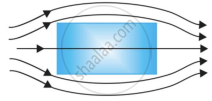Advertisements
Advertisements
प्रश्न
Which of the following substances is ductile?
विकल्प
Glass
High carbon steel
Steel
Copper
उत्तर
Copper
APPEARS IN
संबंधित प्रश्न
Distinguish between ‘paramagnetic’ and ‘ferromagnetic’ substances.
The susceptibility of magnesium at 200 K is 1.8 x 10-5. At what temperature will the susceptibility decrease by 6 x 10-6?
Out of the two magnetic materials, 'A' has relative permeability slightly greater than unity while 'B' has less than unity. Identify the nature of the materials 'A' and 'B'. Will their susceptibilities be positive or negative?
Distinguish between diamagnetic and paramagnetic substances
A meter gauge train is heading north with speed 54 km/hr in earth's magnetic field 3 x 10-4T. The e.m.f. induced across the axle joining the wheels is ..........
(a) 0.45 mV
(b) 4.5 mV
(c) 45 mV
(d) 450 m V
Explain Curie’s law for a paramagnetic substance.
Which of the following substances are diamagnetic?
Bi, Al, Na, Cu, Ca and Ni
The relative magnetic permeability of a magnetic material is 800. Identify the nature of magnetic material and state its two properties.
A tangent galvanometer shows a deflection of 45° when 10 mA of current is passed through it. If the horizontal component of the earth's magnetic field is `B_H = 3.6 xx 10^-5 "T"` and radius of the coil is 10 cm, find the number of turns in the coil.
The magnetic susceptibility of platinum is 0.0001. It's relative permeability is:
Choose the correct option:
A rectangular magnet suspended freely has a period of oscillation equal to T. Now it is broken into two equal halves (each having half of the original length) and one piece is made to oscillate freely. Its period of oscillation is T′, the ratio of T′/T is ______.
What happens to a ferromagnetic material when its temperature increases above curie temperature?
Two identical bar magnets each of magnetic moment M, separated by some distance are kept perpendicular to each other. The magnetic induction at a point at the same distance d from the centre of magnets, is (µ0 = permeability of free space)
For a paramagnetic substance, the magnetic susceptibility is ______.
The susceptibility of a magnetic material is positive and small. The material is ______.
Magnetization of the sample is ______.
Relative permittivity and permeability of a material are `epsilon_"r"` and `µ_"r"` respectively. Which of the following values of these quantities are allowed for a diamagnetic material?
The magnetic property of magnetic substance is associated with ____________.
A domain in a ferromagnetic substance is in the form of a cube of side length 1 µm. If it contains 6 x 1010 atoms and each atomic dipole has a dipole moment of 7 x 10-24 Am2, then magnetization of the domain is ____________.
Which graph shows the variation of magnetic susceptibility (`chi`) with magnetizing field (H) for a paramagnetic substance?
Is the permeability of a ferromagnetic material independent of the magnetic field? If not, is it more for lower or higher fields?
Explain qualitatively on the basis of domain picture the irreversibility in the magnetisation curve of a ferromagnet.
Nickel shows ferromagnetic property at room temperature. If the temperature is increased beyond curie temperature, then it will show ______.
The given figure represents a material which is ______.

Assertion: A paramagnetic sample display greater magnetisation (for the same magnetic field) when cooled.
Reason: The magnetisation does not depend on temperature.
The magnetic susceptibility is negative for ______.
Which of the following property shows the property of ferromagnetic substances?
Earth's magnetic field analyses has a horizontal component except at:-
The universal property of all substances is ______.
According to the Atomic theory, on heating a magnet, the thermal energy of the elementary magnet ______
A paramagnetic sample shows a net magnetisation of 8 Am–1 when placed in an external magnetic field of 0.6 T at a temperature of 4 K. When the same sample is placed in an external magnetic field of 0.2 T at a temperature of 16 K, the magnetisation will be ______.
S is the surface of a lump of magnetic material.
- Lines of B are necessarily continuous across S.
- Some lines of B must be discontinuous across S.
- Lines of H are necessarily continuous across S.
- Lines of H cannot all be continuous across S.
Essential difference between electrostatic shielding by a conducting shell and magnetostatic shielding is due to ______.
- electrostatic field lines can end on charges and conductors have free charges.
- lines of B can also end but conductors cannot end them.
- lines of B cannot end on any material and perfect shielding is not possible.
- shells of high permeability materials can be used to divert lines of B from the interior region.
A permanent magnet in the shape of a thin cylinder of length 10 cm has M = 106 A/m. Calculate the magnetisation current IM.
Explain quantitatively the order of magnitude difference between the diamagnetic susceptibility of N2 (~5 × 10–9) (at STP) and Cu (~10–5).
If the magnetizing field on a ferromagnetic material is increased, its permeability ______.
A uniform magnetic field gets modified as shown in figure when two specimens A and B are placed in it.
 |
 |
| (a) | (b) |
- Identify the specimen A and B.
- How is the magnetic susceptibility of specimen A different from that of specimen B?
- Assertion (A): Diamagnetic substances exhibit magnetism.
- Reason (R): Diamagnetic materials do not have a permanent magnetic dipole moment.
Which of the following has a permeability less than that of free space?
Which of the following cannot modify an external magnetic field as shown in the figure?

Explain ferromagnetism on the basis of the domain theory.
Explain the origin of paramagnetism on the basis of atomic structure.
State the dimensions of magnetization.
